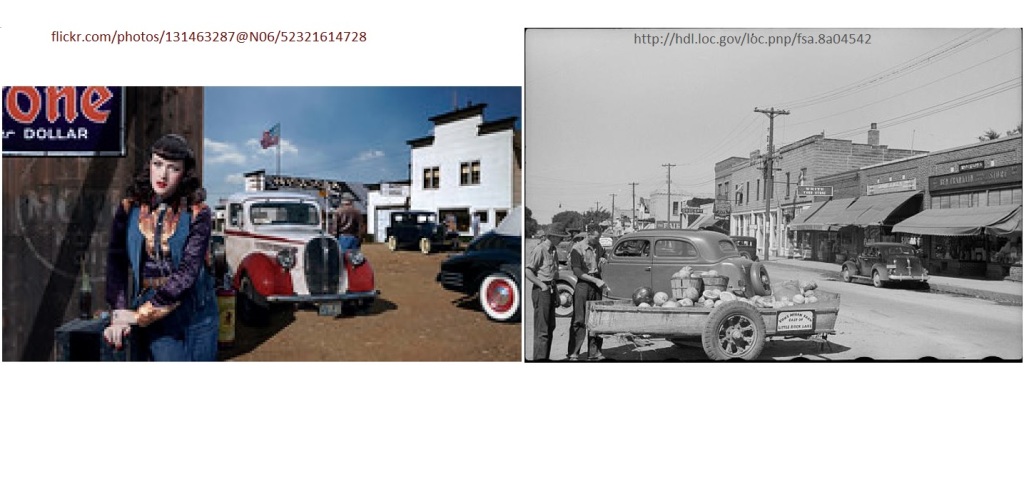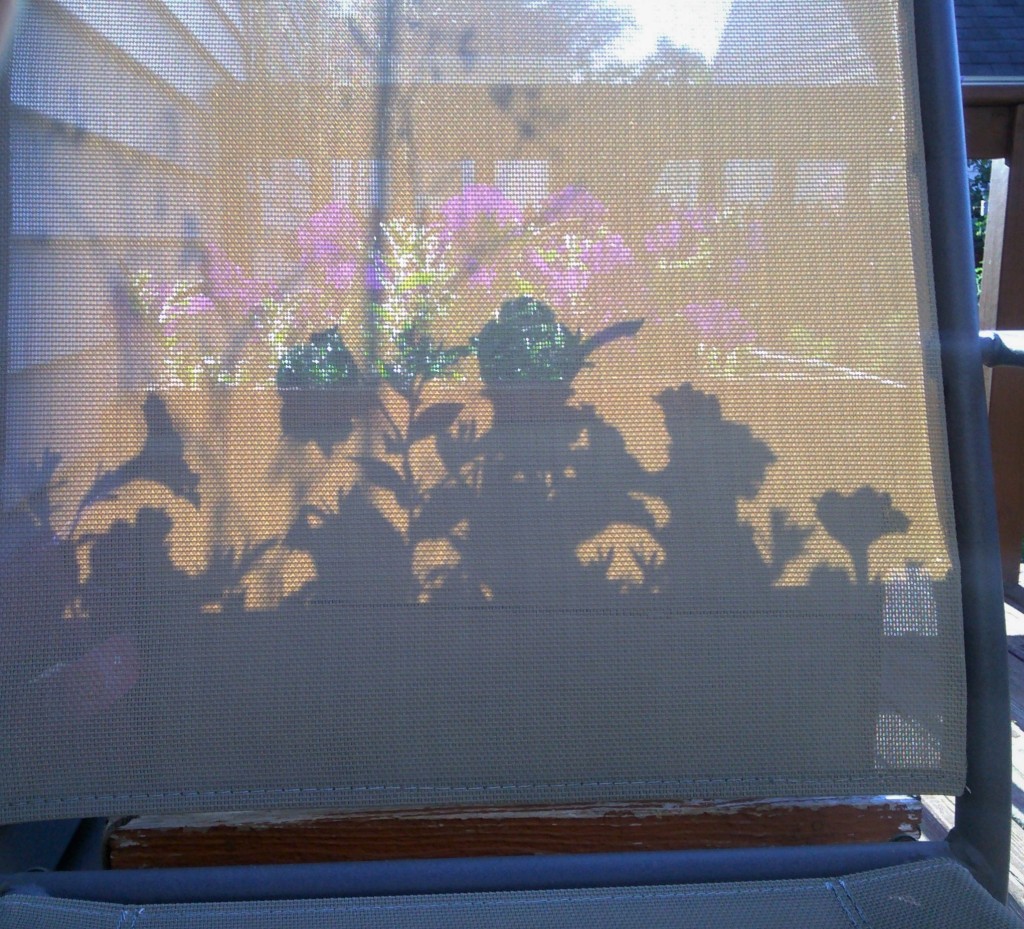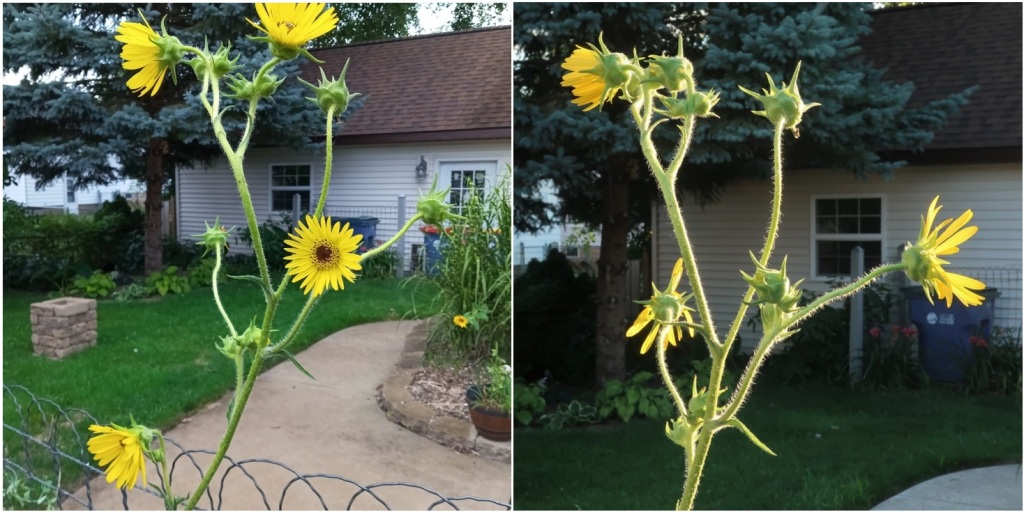
Seeing this color photo today, the many elements trigger associations and image-memories from other times and places. The photographer includes many of those cultural icons and clues in his tags: Coke, Lucky-Strike, Cigarette, Car, USA, US, Porcelain, Ford V8, Cadillac, Western, Cow-Girl, Montana, Pick-Up. The mix of car model-years is realistic, since they date from several years before and up to the target design year. The national flag may well have the 48 stars (one per state; Alaska and Hawai’i came after the time presented here). The hair and make-up seem to fit the time accurately, too. Equally important to the truthiness (facsimile of authenticity) is excluding any modern-day intrusions like satellite dish, fiber-optic overhead cables, contrails of jets, or bits of litter that point to a year far in the future from the target time of circa 1940.
In order to create this outdoor still-life picture, so many props had to be gathered and arranged. Costumes and cars were sourced, modern-day aberrations were removed, lighting had to be coordinated, and each piece of the scene had to be fine-tuned for optimum juxtaposition and use of space, volume, mass, and color. By dint of huge creative talent and imagination, the effect seems natural; at least to a casual viewer. The eye wanders around the scene seeking clues for context (where, when, who is recorded; for what occasion or purpose) and sees old-time products, font-style, and so on. Nothing gives lie to the masterful composition’s performance. And yet, somehow it is not living. Perhaps this is the analogy of “live TV audience” versus a news or entertainment or educational show that has been pre-recorded and edited for optimum production values (best audio, ellipsis of empty passages, sequences rearranged for best grasp or for dramatic effect in viewers, possibly a musical track added to fit, laugh-track judiciously applied). By contrast, while there is risk of unscripted movement, intrusion, or juxtaposition; and when each subject in the frame brings their own purposes and degree of self-awareness (or the reverse, utterly un-selfaware), then the moment frozen at the shutter’s release is “live drama,” not scripted.
There can be a delicate line that separates a purely spontaneous composition snapped on the street versus the incremental intrusion of the photographer’s hand at work to supply a prop to the subject, to frame the place and wait for desired movement to fill the space, or even deliberately to rearrange the deck chairs to form a pleasing abstraction of shadows in the larger frozen moment. In other words, to some extent, all photos involve the person actively imposing a vision onto the found scene. Choice of lens, settings, framing, and moment of capture make a picture from one person differ to that of another; one perhaps bland, the other edgy. One picture can push to make a political statement or suggested association and insinuation, while another picture can pull the subject into the past by emphasizing its place in history and things gone by. Rather than “taking” pictures that present themselves “as is, ready-made for capture,” it is probably safer to say that pictures are “made” in the many small and large decisions leading up to an exposure being committed to film or memory card.
Besides the controlled composition, hearkening to Pictorialism (efforts to use camera to make pictures with a family resemblance to paintings: light, color, look and feel), the historical congruity (absence of anachronisms shattering the appearance of a historical period scene), the technical excellence (minimizing distractions to viewer immersion in the scene), and plausibility (would such a moment fit the time/place, or is it incongruous) there has to be something more to account for in order to make the “artist’s recreation” as life-like as possible. The analogy of mortician art comes to mind: making a corpse appear life-like offers some comfort to the bereaved family and friends by allowing the last memory to be something like the living person, rather than the organic shell of the personality known and loved. Similarly of a composition that intends a historical recreation: making it as close to real-life as possible does help viewers to remember, or to see for the first time, what the look and feel (indeed, smell and sound and taste) was like. However authentic those realistic effects may appear, what lies under the surface of costumes and props is practically impossible to reestablish. “Playing the part” is more than surface appearances and scripted lines. To come alive the performers must include attitudes and aspirations that fit the moment, too.
What lies under the surface in a “live” photo shoot is immense: personality, intentionality, popular culture, unspoken rules as well as posted rules for behavior, and the unscripted actions and reactions between all the subjects interacting at the time of (snap, spontaneous or semi-preframed) composition. In other words, returning to the two photos at the top of this article, the scripted composition does artfully evoke a particular time and place in a mostly anonymous way. But it differs to the adjacent documentary photo because of granularity of detail (the September 1939 shot in Rice, Minnesota is filled with minutiae), the psychological and cultural past experiences and future hopes carried in the faces and hearts of those present, and the possibility of unexpected subjects appearing or disappearing in the frame, as well as unanticipated reactions or non-reactions between subjects in the picture (adding or reducing dramatic interest).
Turning to the blog theme of “see to think,” perhaps there is something to be learned from this difference between controlled and scripted experience (like the lefthand photo, above) and situations that are unscripted and not rehearsed for public performance or spectating. One lesson has to do with the individual tolerance for order versus disorder: some like their days and lifetimes to be scheduled, budgeted, insured, and guaranteed. Others minimize those foundational parts of their experience and live from moment to moment, reacting rather than planning and accomplishing intended goals. For one person serendipity is incidental, but for the other person the things that fortuitously appear are the fruit of a life well lived; not incidental but primary and valued most highly. Some claim that a tidy space for work and living is necessary for productive and purposeful experience; that disorderliness distracts from creatively organizing and overseeing the step-by-step progress toward a goal. Others see things in the opposite way: too much order and lack of happy collisions of ideas and elements is sterile and lifeless. Leaping to a farming analogy, messy compost is considered the most fertile to grow things in. But so much of industrial scale and low retail prices comes from monocrops at vast scale which depend on fossil fuel energy, synthetic fertilizers, and poisons for animals and plants that consume the crop. Disorderly compost is overflowing with all sorts of life, both visible and invisible; tidy monocropping is a biological desert, by comparison.
Accepting the idea that all photos are “made” and not simply “taken” as they are found, then the same logic may well be true that all thinking is likewise “made” and not simply “taken”; in other words, the person who is engaging in a scene or in an intellectual exploration cannot but help from imposing some particular way of composing and selectively (subjectively) interacting with what presents itself. At one extreme the composition is conceived, arranged, and captured entirely from the artist’s imagination (fiction in its literal meaning of “made”). At the other extreme the composition is recognized for something of innate visual interest –the light, the conflicting meanings, the unusual circumstance or newsworthy moment (non-fiction in its literal meaning of “not made” but found as is). But few photos, and by extension few thoughts, fit into the extreme ends of this spectrum. Instead, just about all of them are some combination –partly “made” and partly “found” and received as is. As a result, and as in the above two photo examples, some cases are more “alive” with possibility than others. Some foreclose alternative readings; others open up more than one way to see the image.


